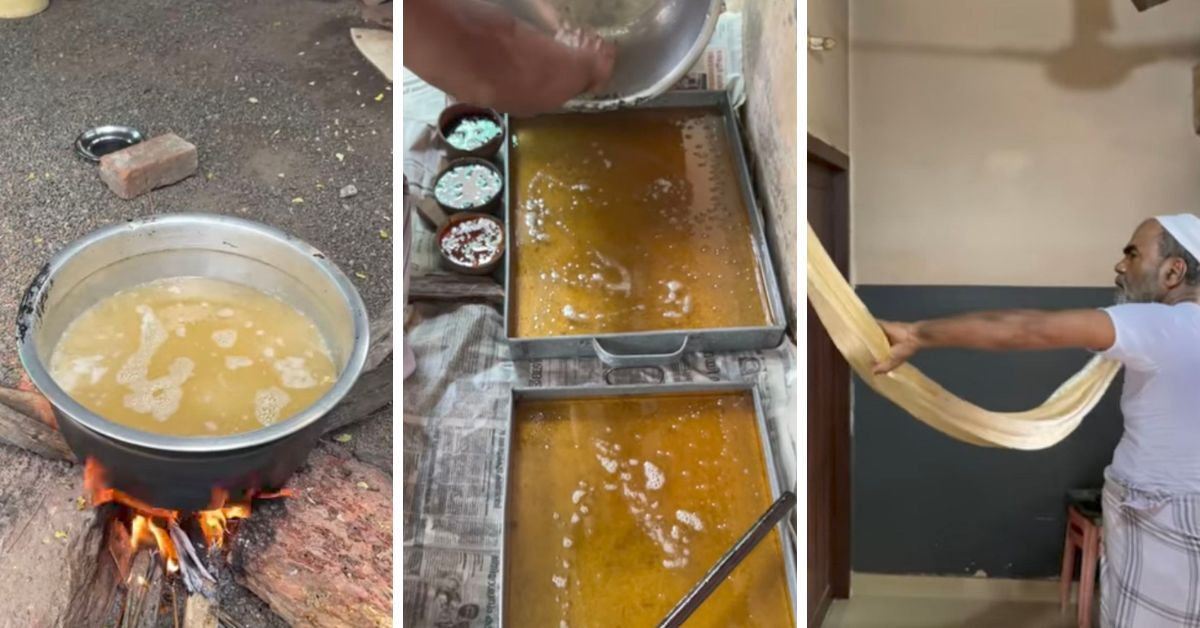In the early 1930s, Aboobacker — a teenage boy from Kayamkulam, Kerala — ran away from his home after an argument with his father. He took a bus to Tamil Nadu and took up multiple jobs to survive. In a few years, he joined a team of ‘jow mittai’ (sugar candy) makers in Nagore.
Aboobacker, who started as a helper, slowly went about making the candies on his own. He later shifted to his homeland in Kerala, got married and had three sons. Even then, the family’s only means of livelihood was the candy business.
From a very young age, Aboobacker’s sons began helping their father to make jow mittai, which is known as panjara paalu mittayi (sugar-milk candy) in Malayalam. Today, in the words of A T Basheer, Aboobacker’s second son, the brothers are the only ones who prepare and sell this nostalgic candy in the state.
“There is a popular song from a Malayalam film which starts with the line ‘panjaara paalu mittayi.’ My father used to sing this song — written by poet Vayalar Ramavarma — while selling candy. Neither I nor my brother could sing like him, but we sure know how to make a perfect mittayi,” says Basheer. Better known as Mittayi Basheer among the residents of Kozhikode, he has been selling this traditional candy for the past 48 years.
Candy-making: A half-day process

The candy is prepared once every two days by setting a traditional firewood stove in front of his house. Every alternate morning, 10 kg of sugar is mixed in five glasses of water and the juice of two lemons is added to this mixture. It is then boiled in a big tumbler.
Basheer mixes the ingredients for half an hour straight until it reaches a certain stage in which the candy can be expanded using hands, after cooling down.
“If the boiling and mixing are not done right, all the ingredients would be wasted. Full attention and care are required,” says the 62-year-old who manages the entire process alone.
The boiled mix is then added to coconut oil-coated flat tumblers to cool down. A small portion of the mix is added to little bowls with a pinch of food colouring.
“After cooling down, the mix is flattened and stretched just like preparing Kerala porotta (flatbread). This tedious process is continued for about an hour which results in thin customisable candies. You can even make a one-metre string using a pinch of this batter,” explains the skilled candy maker, who holds a licence from the Food Safety and Standards Authority of India (FSSAI) to sell the sweet.
“The candy-making process is a strenuous task. Earlier, my father and elder brother used to help in the preparation. But post their death and my younger brother’s shift to Thirunavaya, I now manage everything alone. I have four children, but none are interested in the making. I will continue to mould and sell the candies till my health allows it. I would love to share the process with anyone who is interested,” says the sexagenarian.
A cache of colourful candies
When the afternoon sun comes down, Basheer picks up his decades-old small trunk box filled with 5 kg of sugar candy and walks to South Beach. This has been his routine since 1970.
One can spot children and adults surrounding Basheer near the beach to have their favourite candy in different shapes. Basheer creates any shape that the customer asks for – right from a motorcycle to a watch, and a butterfly to an elephant! He uses the candy batter that is prepared in its original colour (white) along with small portions of the other three colours.
“During my father’s time, I remember selling candy for 5-10 paisa. Today, the price is Rs 10. Most of my customers here are adults who used to love eating candies as kids. I feel so happy when they say that relishing it brings back tonnes of childhood memories. Sometimes, they come with their kids too to try the sweet which is rarely available in Kerala these days,” shares Basheer.
Aswindevan K, a resident of Kozhikode, who tried this candy recently says, “I have heard from my parents about this sweet and from the famous song. It tastes like cotton candy but what’s interesting is the shapes Basheer ikka makes using it. He is so skilled in it. I saw a lot of kids around him asking for their favourite shape and relishing the sweet. I am sure it will be part of their nostalgia too after many years.”
Basheer also adds that while there are several jow mittai sellers in Tamil Nadu, he doesn’t know anyone other than him and his brother who prepare the candy in Kerala.
This candy maker further shares that they earn about Rs 2000 per day, out of which Rs 500 is used for picking up the ingredients. Basheer also takes up wedding orders now and then from people who consider panjara paalu mittayi to be a taste of their childhood.
And at the end of the day, that’s what Basheer strives for too.
Photo credits: A T Basheer, YouTube/Harish Thali, Wandering Foodie.
Edited by Pranita Bhat
If you found our stories insightful, informative, or even just enjoyable, we invite you to consider making a voluntary payment to support the work we do at The Better India. Your contribution helps us continue producing quality content that educates, inspires, and drives positive change.
Choose one of the payment options below for your contribution-
By paying for the stories you value, you directly contribute to sustaining our efforts focused on making a difference in the world. Together, let's ensure that impactful stories continue to be told and shared, enriching lives and communities alike.
Thank you for your support. Here are some frequently asked questions you might find helpful to know why you are contributing?

